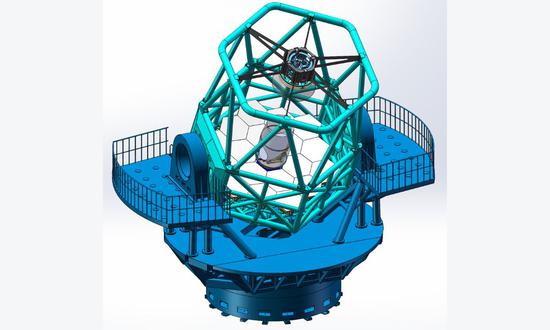
The JUST schematic diagram (Photo/Screenshot of the official website of the Shanghai Jiao Tong University Spectroscopic Telescope (JUST) project)
China has achieved a major milestone in astronomical research with the launch of the Jiao Tong University Spectroscopic Telescope (JUST) project. On Sunday, construction officially began on the 4.4-meter telescope at the Lenghu Astronomical Observation Base in Northwest China's Qinghai Province.
Upon completion, it will become China's first large-scale, domestically developed spectroscopic telescope, marking a significant leap forward in the nation's pursuit of independent space observation capabilities.
The JUST telescope will enhance China's ability to study galaxy clusters, transient cosmic phenomena, and exoplanets, further advancing the country's position in global astronomical research, according a report by thepaper.cn.
The JUST telescope has three primary scientific objectives. First, it will employ its high-density fiber spectroscopic capabilities to survey dense regions of the universe, such as galaxy clusters, significantly advancing research in cluster cosmology. Second, its rapid-response design will enable prompt follow-up observations of transient phenomena like supernovae, which are difficult to study due to their short-lived nature. Third, it will focus on exoplanet detection by observing multiple bright stars using high-resolution spectrometers.
These goals highlight the JUST telescope's pivotal role in strengthening China's astronomical research capabilities, according to thepaper.cn.
The telescope will be installed at the Lenghu Astronomical Observation Base, situated at an altitude of about 4,000 meters atop Saishengteng Mountain. The location was carefully chosen due to its favorable natural conditions: dry climate, low water vapor levels, and excellent atmospheric stability.
Furthermore, the region's sparse population ensures minimal light pollution, creating optimal conditions for high-quality astronomical observations. These environmental factors make Lenghu one of the best locations for astronomical operations, per thepaper.cn report.
The telescope's design features a primary mirror composed of 18 hexagonal segments, and its lightweight structure will help enhance performance. Equipped with three high-performance observational instruments - a multi-target fiber spectrometer, an integral field spectrometer, and a high-resolution spectrometer - the telescope is expected to make major contributions to the study range of astronomical phenomena. Its efficient and rapid response capabilities will be crucial for gathering data on transient sources and other cosmic events.
Moreover, the construction of the JUST telescope incorporates an innovative SMC-arched steel modular product system, which is designed to reduce water and electricity consumption by up to 70 percent and decrease construction waste by 85 percent. These efforts not only improve construction efficiency but also promote energy conservation and ecological sustainability.
The completion of the JUST telescope represent a major milestone in China's astronomical development, positioning it as a world-class "eye to the stars." Additionally, JUST will complement other domestic telescopes, such as the Mozi (WFST) and CSST, by providing essential follow-up spectroscopic observations of transient sources, helping scientists to better investigate their physical properties.
Beyond the JUST project, China's FAST (Five-hundred-meter Aperture Spherical Radio Telescope) continues to lead global advancements in radio astronomy. Located in Southwest China's Guizhou Province, FAST remains the world's largest single-dish radio telescope. Since its formal operations began in January 2020, and opening to international researchers in March 2021, FAST has made major contributions to the discovery of pulsars, the Xinhua News Agency reported.


















































 京公網安備 11010202009201號
京公網安備 11010202009201號